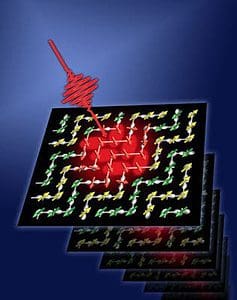Driven by technological demand to breach the gigahertz (10^9 hertz) switching speed limit of today’s magnetic memory and logic devices, a team of researchers have devised a novel technique of switching magnetism that is at least 1000 times faster than that currently employed opening up the terahertz age (10^12 hertz).
Hard drives, magnetic random access memory (RAM) and other computing devices typically employ magnetic switching to encode information and the speed at which this occurs governs how fast at their own term these devices can write, read, store and compute information.

Scientists the U.S. Department of Energy’s Ames Laboratory, Iowa State University, and the University of Crete in Greece have claim they have breached the terahertz barrier for magnetic memory technologies using laser pulses to create ultra-fast changes in the magnetic structure, within quadrillionths of a second (femtosecond), from anti-ferromagnetic to ferromagnetic ordering in colossal magnetoresistive materials (CMRs). Current commercial technology works at the gigahertz range.
Colossal magnetoresistive materials are a novel type of materials that promise to shape the way we judge performance once with their introduction in the next-generation memory and logic devices. CMRs are so appealing because of they’re amazingly responsive to the external magnetic fields used to write data into memory, but do not require heat to trigger magnetic switching.
Current magnetic storage and magneto-optical recording technology work to encode information by employing both optics and heat. To be more specific, typically a continuous laser light is used to zap a ferromagnetic materials that heats up and vibrates. This vibration of the material’s atoms, in conjunction with a magnetic field, causes magnetic flips. The speed with which this thermal magnetic switching occurs is thus limited since you need to wait for the atoms to become excited and vibrate, which makes it very difficult to cross the gigahertz barrier. Devoid of such a limitation, by using all-optical switching, this limit can now be breached.
Ames Laboratory physicist Jigang Wang and his team used ultra-fast laser spectroscopy, shooting short pulses of laser light to excite a material and trigger a measurement all on the order of femtoseconds.
“In one CMR manganite material, the magnetic order is switched during the 100-femtosecond-long laser pulse. This means that switching occurs by manipulating spin and charge quantum mechanically,” said Wang. “In the experiments, the second laser pulse ‘saw’ a huge photo-induced magnetization with an excitation threshold behavior developing immediately after the first pump pulse.”
The fast switching speed and huge magnetization that Wang observed meet both requirements for applying CMR materials in ultra-fast, terahertz magnetic memory and logic devices.
“Our strategy is to use all-optical quantum methods to achieve magnetic switching and control magnetism. This lays the groundwork for seeking the ultimate switching speed and capabilities of CMR materials, a question that underlies the entire field of spin-electronics,” said Wang. “And our hope is that this means someday we will be able to create devices that can read and write information faster than ever before, yet with less power consumed.”
Findings were reported in the journal Nature.


